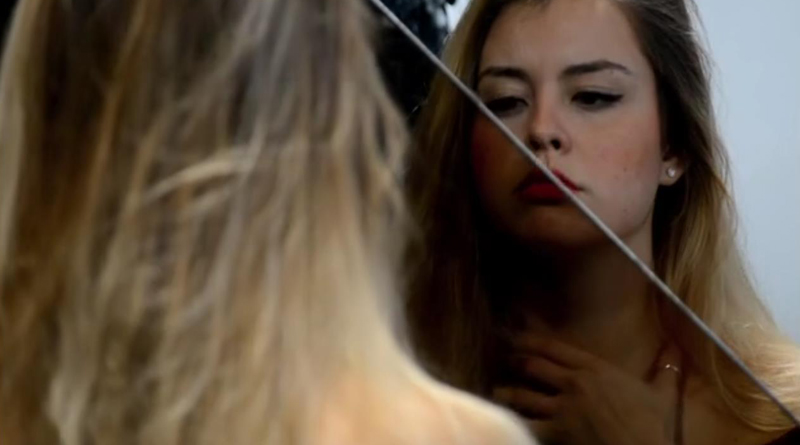Le Collier

Le Collier
Directed by Pio Bruno | Review by TRIPTAYAN CHATTERJEE
Among the buzzing dreams and hard reality, with a film language of a tremendous level, Mathilda is standing before the mirror where she is trying to judge in which dress she looks most beautiful in. This scene lasts for a considerable time and the mirror is having a long scratch from left to right diagonally where her face and body divided into two parts in the image. For the basic scientific cause, the joining of the two parts of the mirror in the scratch gives two slightly different images of Mathilda, which is beautifully captured with the camera. And that’s a small masterstroke of cinema, where two different existences of one human being is shown in a unique way. It shows it’s the film language which is an inevitable condition of a good cinema, not so much the idea. Mathilda is dreaming of her expected gorgeous life and suffering from the practical life every now and then, which is shown by her fragmented images in the mirror and the difference of this two lives is symbolized by that big scratch. The film’s director and scriptwriter Pio Bruno have done a masterful job right from the first few seconds.

Examples of many more masterstrokes are scattered in the entire film which is actually an adaptation of the famous short story of Guy De Maupassant, THE NECKLACE. Maupassant is not followed, actually retold with respect to the twenty-first century global urban society where class division still exists and politics do not care for that, instead injects the opportunist ideology in own favor. The film walks down something really unique. The universality of the THE NECKLACE in the nineteenth century spreads the message that the conflict between dream and reality, honesty and dishonesty, having or not having are not always the psychological truth, sometimes it is manmade like by the states, by greater politics, by the class divisions of the society. Pio has tried to reflect it within the span of five years of the early twenty-first century. The eighteenth century’s Mathilda’s love Mario honestly and looks for the lost necklace in 2014. Political and state system has changed a lot in this more than a hundred years but the message is the same, the order of the society remains unchanged. The necklace was borrowed by Mathilda from her friend Gissele for attending a party given by the son of a minister under whom Mario was working for a living. Ignorant Mathilda, according to her mediocre mentality claimed good dress, precious jewelry from Mario to attend the party. In the entire film only one constant dialogue about honesty and livelihood is heard from every character, actor like the election candidate, minister, media and even from the neighbors. The very delicate opportunist ideology gets injected everywhere in the society, which makes the dream and reality of Mario and Mathilda harder and harder. The background scenes of the film sometimes narrate the evolutions of the human and social characters through portraits, pictures, landscapes, posters and all others fact and figures. It is an astounding reflection of a universal sensibility. The linear story has no branch, no gimmick. The impressions of the actors are so natural and unique that sometimes assimilates our own life and thought process.

The special effect dance scene by Mathilda, it’s effective impression expresses her fight against the odds she is facing along with the protest against the socio-economic political structure of the society, though French, applicable in the international arena. Nowadays where cinema is being created on only the cinematography, technology and editing, the director has gone through a parallel way with the wonderful film language, an essential condition of a good cinema. Actors and actresses have gone through the fair acting with appropriate impression without any melodramatic approach. The camera is used accordingly, not overshadowing the real flavor of the film. Guy the Maupassant has used the necklace itself as a symbol of a high-rich society. But the Director has used it as the conflict point of the two layers of the society. The final scenes of the films are extremely cinematic. The static shot of Mathilda sends us a message that, all the things are running in often unwanted fashion. There is no difference between these two centuries and time altogether. It puts a universal question mark before us to reply. The necklace is the symbol of the society, social order, individual fight. The reality of hidden life at a par with the enjoyable life visible from overlayer of the society is beautifully told in the film.
 Triptayan is a filmmaker looking for a different horizon. Earlier a journalist Triptayan has done intensive research on film language and made different documentaries so far. He is now concentrating upon feature film in a vast landscape. Professionally a teacher, Triptayan has also passion for making films threaded with the international and universal thoughts.
Triptayan is a filmmaker looking for a different horizon. Earlier a journalist Triptayan has done intensive research on film language and made different documentaries so far. He is now concentrating upon feature film in a vast landscape. Professionally a teacher, Triptayan has also passion for making films threaded with the international and universal thoughts.


